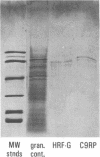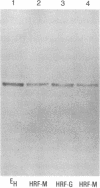Abstract
A soluble form of homologous restriction factor (HRF) has been isolated from the cytoplasmic granules of human large granular lymphocytes that were cultured in the presence of recombinant interleukin 2 for 2-3 weeks. The granule-derived protein (approximately 65 kDa) is soluble in detergent-free solution and reacts with antibody produced to membrane HRF. HRF was first described as a 65-kDa membrane protein of human erythrocytes capable of inhibiting the formation of transmembrane channels by the membrane attack complex of complement. It has also been isolated from activated human lymphocytes and shown to confer upon these cells relative resistance to lysis by the membrane attack complex and by the complement component C9-related protein of human cytotoxic lymphocytes. The soluble HRF of lymphocyte granules inhibits reactive lysis of erythrocytes by the membrane attack complex of human complement. It was also found to be a potent inhibitor of (i) the cytolytic activity of the C9-related protein of human cytotoxic lymphocytes, (ii) human large granular lymphocyte cytotoxicity, and (iii) the cytotoxic activity of human CD8+ lymphocytes obtained by cell sorting from recombinant interleukin 2-activated peripheral blood mononuclear cells. It is proposed that granule-derived soluble HRF and cell surface-membrane-bound HRF are involved in the mechanism of self-protection of killer lymphocytes.
Full text
PDF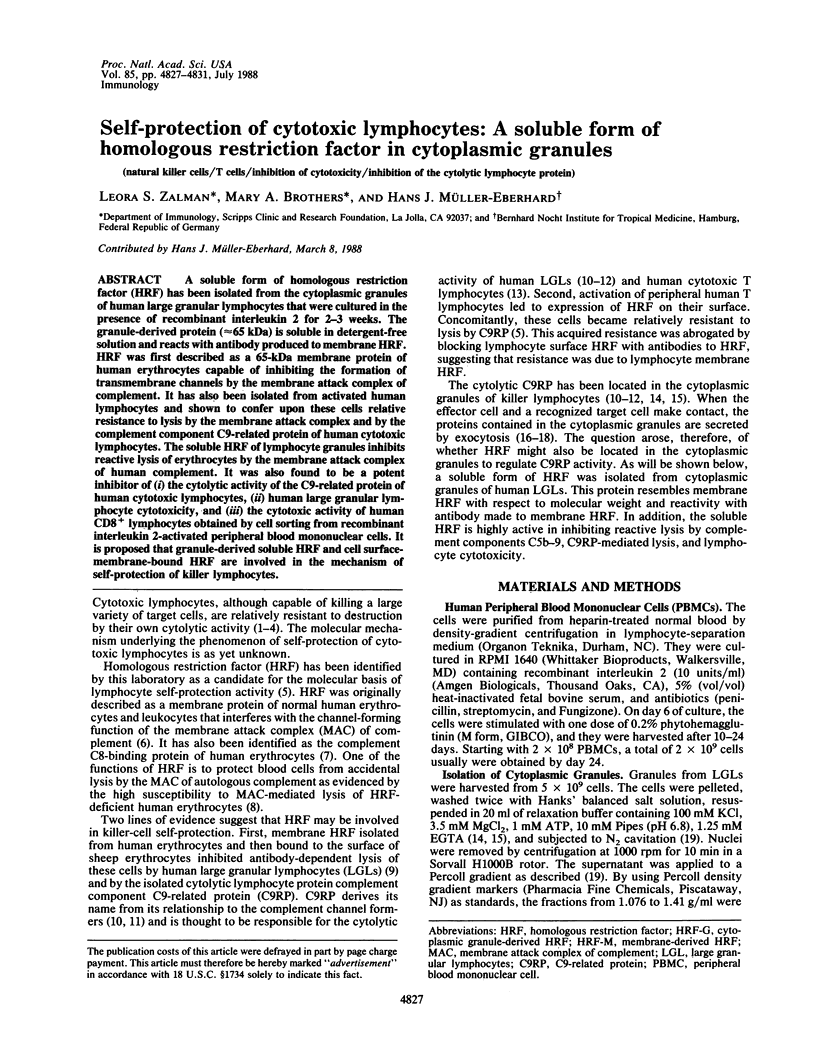

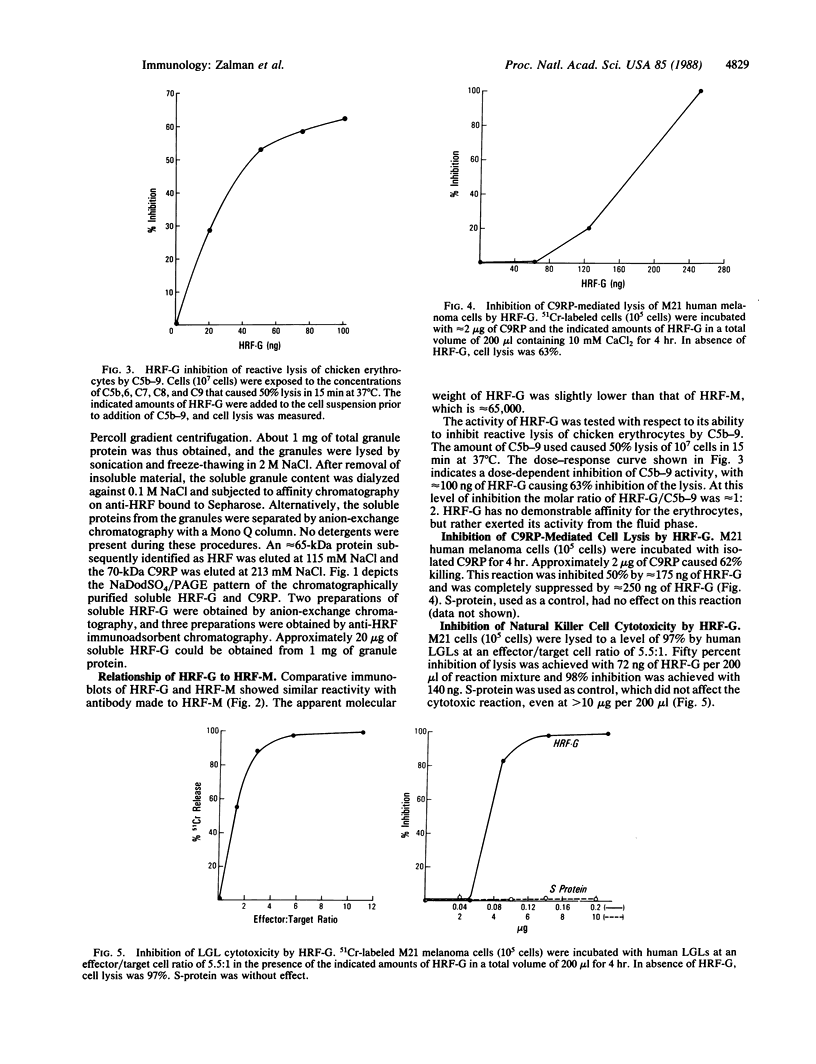
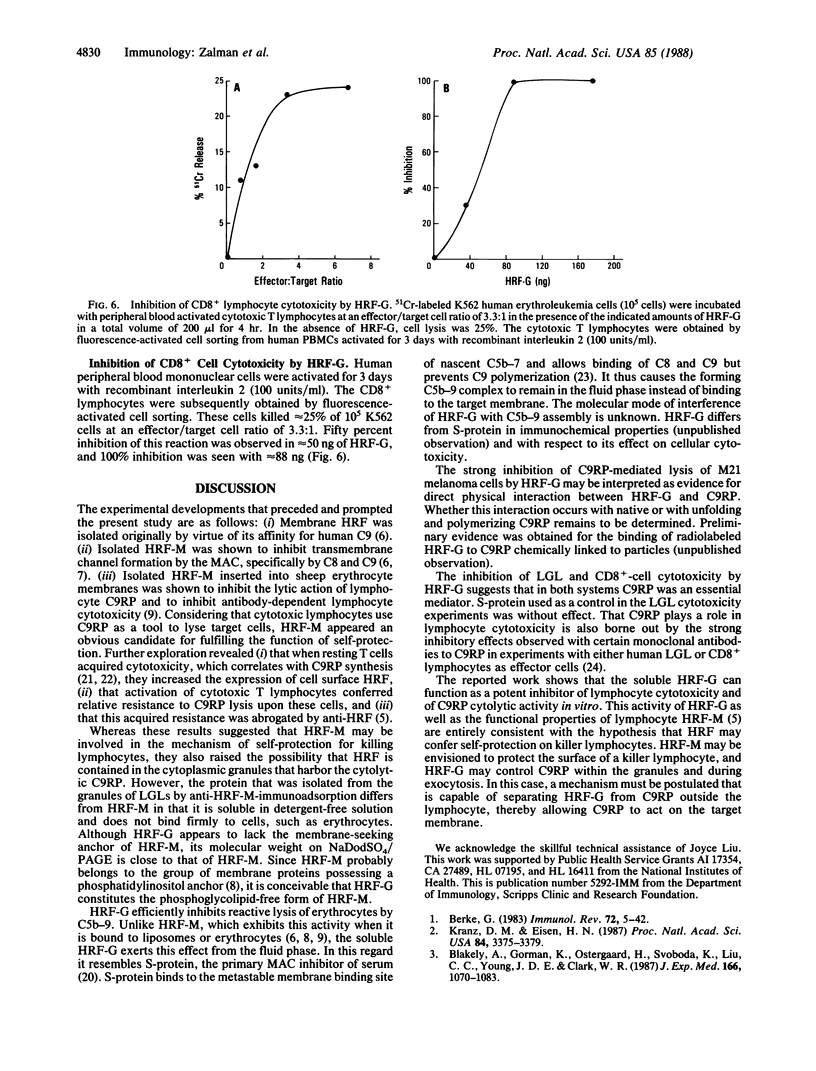
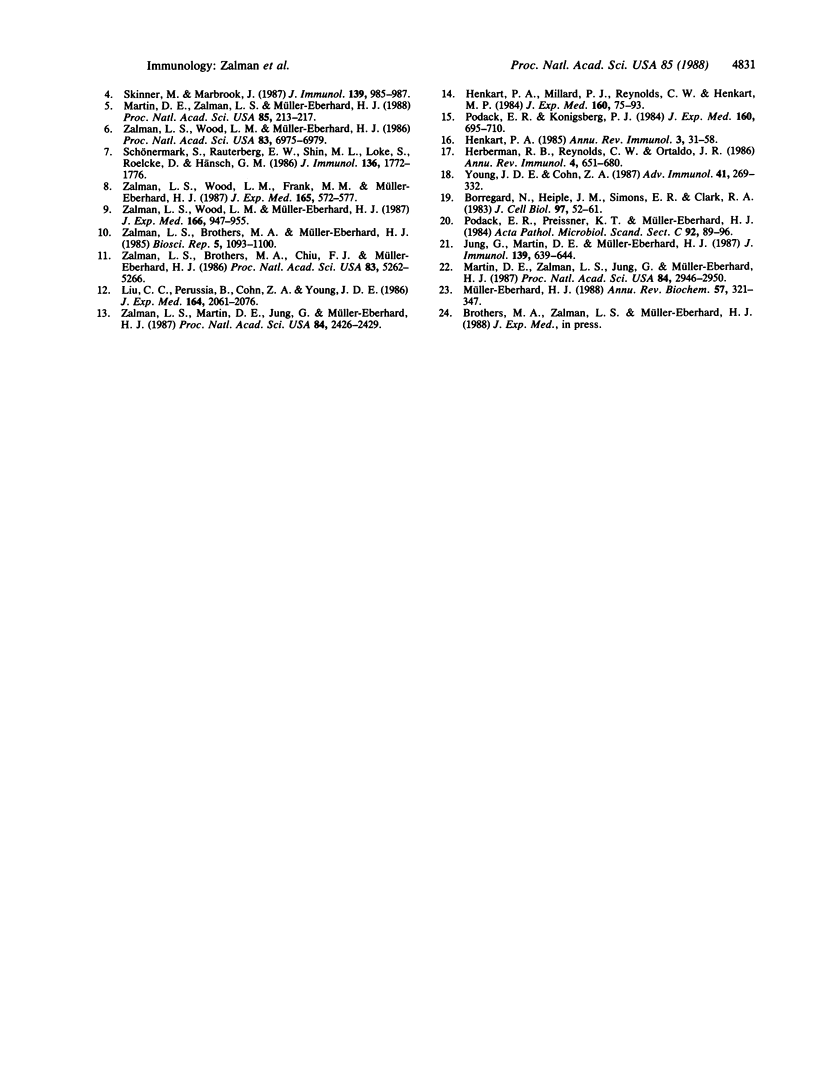
Images in this article
Selected References
These references are in PubMed. This may not be the complete list of references from this article.
- Berke G. Cytotoxic T-lymphocytes. How do they function? Immunol Rev. 1983;72:5–42. doi: 10.1111/j.1600-065x.1983.tb01071.x. [DOI] [PubMed] [Google Scholar]
- Blakely A., Gorman K., Ostergaard H., Svoboda K., Liu C. C., Young J. D., Clark W. R. Resistance of cloned cytotoxic T lymphocytes to cell-mediated cytotoxicity. J Exp Med. 1987 Oct 1;166(4):1070–1083. doi: 10.1084/jem.166.4.1070. [DOI] [PMC free article] [PubMed] [Google Scholar]
- Borregaard N., Heiple J. M., Simons E. R., Clark R. A. Subcellular localization of the b-cytochrome component of the human neutrophil microbicidal oxidase: translocation during activation. J Cell Biol. 1983 Jul;97(1):52–61. doi: 10.1083/jcb.97.1.52. [DOI] [PMC free article] [PubMed] [Google Scholar]
- Henkart P. A. Mechanism of lymphocyte-mediated cytotoxicity. Annu Rev Immunol. 1985;3:31–58. doi: 10.1146/annurev.iy.03.040185.000335. [DOI] [PubMed] [Google Scholar]
- Henkart P. A., Millard P. J., Reynolds C. W., Henkart M. P. Cytolytic activity of purified cytoplasmic granules from cytotoxic rat large granular lymphocyte tumors. J Exp Med. 1984 Jul 1;160(1):75–93. doi: 10.1084/jem.160.1.75. [DOI] [PMC free article] [PubMed] [Google Scholar]
- Herberman R. B., Reynolds C. W., Ortaldo J. R. Mechanism of cytotoxicity by natural killer (NK) cells. Annu Rev Immunol. 1986;4:651–680. doi: 10.1146/annurev.iy.04.040186.003251. [DOI] [PubMed] [Google Scholar]
- Jung G., Martin D. E., Müller-Eberhard H. J. Induction of cytotoxicity in human peripheral blood mononuclear cells by monoclonal antibody OKT3. J Immunol. 1987 Jul 15;139(2):639–644. [PubMed] [Google Scholar]
- Kranz D. M., Eisen H. N. Resistance of cytotoxic T lymphocytes to lysis by a clone of cytotoxic T lymphocytes. Proc Natl Acad Sci U S A. 1987 May;84(10):3375–3379. doi: 10.1073/pnas.84.10.3375. [DOI] [PMC free article] [PubMed] [Google Scholar]
- Liu C. C., Perussia B., Cohn Z. A., Young J. D. Identification and characterization of a pore-forming protein of human peripheral blood natural killer cells. J Exp Med. 1986 Dec 1;164(6):2061–2076. doi: 10.1084/jem.164.6.2061. [DOI] [PMC free article] [PubMed] [Google Scholar]
- Martin D. E., Zalman L. S., Jung G., Müller-Eberhard H. J. Induction of synthesis of the cytolytic C9 (ninth component of complement)-related protein in human peripheral mononuclear cells by monoclonal antibody OKT3 or interleukin 2: correlation with cytotoxicity and lymphocyte phenotype. Proc Natl Acad Sci U S A. 1987 May;84(9):2946–2950. doi: 10.1073/pnas.84.9.2946. [DOI] [PMC free article] [PubMed] [Google Scholar]
- Martin D. E., Zalman L. S., Müller-Eberhard H. J. Induction of expression of cell-surface homologous restriction factor upon anti-CD3 stimulation of human peripheral lymphocytes. Proc Natl Acad Sci U S A. 1988 Jan;85(1):213–217. doi: 10.1073/pnas.85.1.213. [DOI] [PMC free article] [PubMed] [Google Scholar]
- Müller-Eberhard H. J. Molecular organization and function of the complement system. Annu Rev Biochem. 1988;57:321–347. doi: 10.1146/annurev.bi.57.070188.001541. [DOI] [PubMed] [Google Scholar]
- Podack E. R., Konigsberg P. J. Cytolytic T cell granules. Isolation, structural, biochemical, and functional characterization. J Exp Med. 1984 Sep 1;160(3):695–710. doi: 10.1084/jem.160.3.695. [DOI] [PMC free article] [PubMed] [Google Scholar]
- Podack E. R., Preissner K. T., Müller-Eberhard H. J. Inhibition of C9 polymerization within the SC5b-9 complex of complement by S-protein. Acta Pathol Microbiol Immunol Scand Suppl. 1984;284:89–96. [PubMed] [Google Scholar]
- Schönermark S., Rauterberg E. W., Shin M. L., Löke S., Roelcke D., Hänsch G. M. Homologous species restriction in lysis of human erythrocytes: a membrane-derived protein with C8-binding capacity functions as an inhibitor. J Immunol. 1986 Mar 1;136(5):1772–1776. [PubMed] [Google Scholar]
- Skinner M., Marbrook J. The most efficient cytotoxic T lymphocytes are the least susceptible to lysis. J Immunol. 1987 Aug 15;139(4):985–987. [PubMed] [Google Scholar]
- Young J. D., Cohn Z. A. Cellular and humoral mechanisms of cytotoxicity: structural and functional analogies. Adv Immunol. 1987;41:269–332. doi: 10.1016/s0065-2776(08)60033-4. [DOI] [PubMed] [Google Scholar]
- Zalman L. S., Brothers M. A., Chiu F. J., Müller-Eberhard H. J. Mechanism of cytotoxicity of human large granular lymphocytes: relationship of the cytotoxic lymphocyte protein to the ninth component (C9) of human complement. Proc Natl Acad Sci U S A. 1986 Jul;83(14):5262–5266. doi: 10.1073/pnas.83.14.5262. [DOI] [PMC free article] [PubMed] [Google Scholar]
- Zalman L. S., Brothers M. A., Müller-Eberhard H. J. A C9 related channel forming protein in the cytoplasmic granules of human large granular lymphocytes. Biosci Rep. 1985 Dec;5(12):1093–1100. doi: 10.1007/BF01119631. [DOI] [PubMed] [Google Scholar]
- Zalman L. S., Martin D. E., Jung G., Müller-Eberhard H. J. The cytolytic protein of human lymphocytes related to the ninth component (C9) of human complement: isolation from anti-CD3-activated peripheral blood mononuclear cells. Proc Natl Acad Sci U S A. 1987 Apr;84(8):2426–2429. doi: 10.1073/pnas.84.8.2426. [DOI] [PMC free article] [PubMed] [Google Scholar]
- Zalman L. S., Wood L. M., Frank M. M., Müller-Eberhard H. J. Deficiency of the homologous restriction factor in paroxysmal nocturnal hemoglobinuria. J Exp Med. 1987 Feb 1;165(2):572–577. doi: 10.1084/jem.165.2.572. [DOI] [PMC free article] [PubMed] [Google Scholar]
- Zalman L. S., Wood L. M., Müller-Eberhard H. J. Inhibition of antibody-dependent lymphocyte cytotoxicity by homologous restriction factor incorporated into target cell membranes. J Exp Med. 1987 Oct 1;166(4):947–955. doi: 10.1084/jem.166.4.947. [DOI] [PMC free article] [PubMed] [Google Scholar]
- Zalman L. S., Wood L. M., Müller-Eberhard H. J. Isolation of a human erythrocyte membrane protein capable of inhibiting expression of homologous complement transmembrane channels. Proc Natl Acad Sci U S A. 1986 Sep;83(18):6975–6979. doi: 10.1073/pnas.83.18.6975. [DOI] [PMC free article] [PubMed] [Google Scholar]



